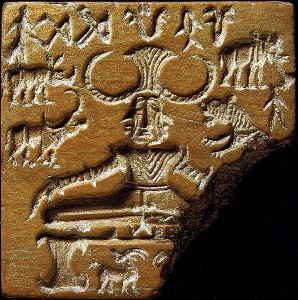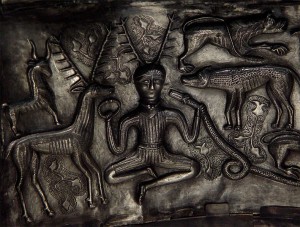Hinduism and the Nature of Paganism
One of my favorite blogs to follow is Jason Pitzi-Waters’ The Wild Hunt. It’s one of the best blogs focusing on Paganism and magick on all of the internet. In a recent post, he describes an article discussing how some younger American Hindus are attempting to create a uniquely American version of Hinduism. He mentions the Hindu American Foundation and how it has actively made an outreach to the Pagan community. Indeed, earlier this year they actively participated at Pantheacon, one of the largest Pagan events in North America.
I deeply applaud this honest and sharing outreach by HAF. I have noticed more and more Pagans interested in Hinduism and would encourage any people interested to continue their research. There are an increasing number of Hindu-oriented rituals and workshops at Pagan festivals and conventions. I strongly support this, too, as I believe:
Information brings wisdom
Wisdom brings understanding
Understanding brings tolerance.
But with this increasing interest in Hinduism, I find myself asking, “Is Hinduism a Pagan Religion?”
What is Paganism?
Some Christian extremists think it is and, to them, far worse. Not being such an extremist, I’m not so sure. Before asking if Hinduism is Pagan, we have to know what Paganism is, and to do that it is important to understand dictionaries.
Contrary to popular belief, dictionaries do not give the “true” or “correct” definition of a term. Rather, they give the popular meanings of a term. Thus, they are used to enhance communication. [Etymological dictionaries are specialized dictionaries showing sources and the evolution of words, but most people don’t regularly use them.] So while we could argue that the source of the term Pagan is this or that, for communicating with people today, it’s important to use the word’s popular meaning. According to my dictionary, the meaning of “Pagan” is:
A person holding religious beliefs other than those of the main world religions.
You may disagree with the definition and have another definition, and that’s fine. I’ve seen some definitions say that a Pagan is someone not part of an Abrahamic religion, that is, not Christian, Moslem, or Jewish. By that definition Hinduism is certainly a Pagan faith, but Hinduism isn’t Pagan according to the dictionary definition.
I think, though, there needs to be more to this definition. For example, I would say that Paganism today either is or tries to reconstruct the faiths that in some instances and in modified form evolved into one of the major religions of the world. I’m not saying that was the intent of ancient Pagan faiths, nor that all Pagan faths did this, only that major religion came out of earlier religions.
There are two implication here. First, as I just wrote, all major religions evolved out of earlier, Pagan religions. They didn’t appear out of thin air and with no predecessor. Second, although it may seem like a contradiction, major religions both simplify and increase the complexity of various aspects of the Pagan religion(s) from which they evolved.
If this is true—and I contend that it is—then Hinduism, as a major world religion (it has over 900 million followers), is not Pagan. Therefore, by my contention, it must have a Pagan precursor. But what?
What is Hinduism?
Part of the problem with the question of Hinduism and Paganism is that unlike the Abrahamic religions, Hinduism is more accurate termed a collection of faiths with some similar concepts. Under the umbrella of “Hinduism” people have widely and wildly varying practices, often worshipping different gods and goddesses of the enormous Hindu pantheon of deities.
But are these deities different? To some Hindus they are. To others, they are simply manifestations of the ultimate single divinity known as Brahman (not to be confused with Brahma, the god of creation). To them, Hinduism is monotheistic with thousands of gods. Complex and confusing? It can be, but that may be because it’s derived from an earlier Pagan tradition, one that is rarely discussed.
Before Hinduism
Before Hinduism became the main religion of the Indian subcontinent, there was another civilization to India’s immediate west. It was known as the Indus Valley Civilization or, named after one of its massive cities, the Harrapan culture. This culture lived along a major river, the Saraswati, until that river dried up.
Remains of a small part of the massive city of Mohenjodaro.
One of the cities of the Harrapan culture.
During this drying time, the people of the civilization slowly moved southeast into India and Ceylon, northeast to Tibet and China, and west into Europe. The root of the ancient Sanskrit word for “knowledge” is vid and a similar word for “tree” is dru. Thus, the people who brought this knowledge to the Pagans of Europe where known as the people with “knowledge of the trees,” the Dru-vids or Druids.
One of the deities worshiped by this culture was Shiva. In the form of Lord of Animals he was called Pashupati. Here is an image of his seal, found in the city of Mohenjodaro:
 Note the cross-legged posture and that he, in his horned form, is surrounded by animals. The seal is about 5,000 years old. The tiger on the right is a symbol of Shiva. Shiva’s legs are shown in a yogic posture with the heels pressing against the perineum, what is known as a banda or lock.
Note the cross-legged posture and that he, in his horned form, is surrounded by animals. The seal is about 5,000 years old. The tiger on the right is a symbol of Shiva. Shiva’s legs are shown in a yogic posture with the heels pressing against the perineum, what is known as a banda or lock.
 Photo by Bloodofox
Photo by Bloodofox
Above we see a very similar image, with but one foot pressed into the perineum. This image, however, was found in 1891 on an elaborate cauldron. Dated to over 2,000 years ago, the cauldron is currently named after the town near which it was found, Gundestrup. Gundestrup is in Denmark.
So if Hinduism is the major religion that evolved out of an earlier Pagan religion, and this earlier Pagan religion influenced the very nature of Paganism throughout Europe, I think we should learn more about this ancient Pagan religion.
More on this to follow in a future post!











Doesn’t modern Wicca take a similar view of deities, with the Goddess as the spirit of everything and the other deities as facets of that? It sounds close to the Hindu perception of Brahman.
Different Wiccan traditions have different approaches.
1)Hinduism is not real name.The name was given by westerners.The real name is Sanatana Dharma(eternal religion)
2)The foundation of this religion is based on Vedas.
3)There is no founder for this religion.
4)Vedas are timeless scripture.
5)It existed even before Indus Valley Civilization.
6)Vedas stats “Ekamevadvitiyam Brahma”(God is one alone without a second)
7)It believes in all religions as there can more than one path to reach the truth.It gives flexibility to people.It allows people to worship one god in different forms.It even gives space for atheistic philosophy.
8)And therefore earlier Pagan religion was nothing but
Sanatana Dharma.
If you want know more about Sanatana Dharma,i can recommend some books.
Hello, Seshadri, and thank you for your comments. Yes, the combined faiths commonly known as Hinduism are more accurately termed Sanatana Dharma, actually meaning “eternal law,” with “law” meaning “natural law” more than “civil law.” The name “Hindu,” however, was not given by Westerners. It was first used by invading Arabs of the 7th century, c.e., to whom it meant the “people on the other side of the Indus river.” In Persia (modern-day Iran), the word “Hindu” came to mean all people of India. It was only in the 18h century that European merchants started to refer to the religions of India as Hinduism and the term wasn’t introduced into English until the following century. I realize that what you present are the standard beliefs of Vedic Hinduism. But just as some Westerners believe that the world is only about 6,000 years old and Moses wrote the first five books of the Bible—including describing his own death and after—to quote Ira Gershwin, “It Ain’t Necessarily So.”
Mr. Kraig, you are exactly right about it’s history, but we can actually take it one step further. Before Judaism became a standard, with Moses and his epiphany, many of his peoples and surrounding communities were polytheistic. We have to remember the history of the area as well. There were many trade routes coming from the east and more exploration from seas and rivers for trade from the south and east. Yes, as far back as 8,000 yrs ago or more. This older civilization of Mohenjodaro did as you reported. With their religious beliefs of a main center of worship with many sub deities under it’s command. Lord Krishna and Rama are ancient historical figures that had special “abilities” and connections with their deity. He was given deity honors. There are many stories of his life that are similar to the Jewish prophecy about their messiah. It is changed to fit their culture, but much of Krishnas and the Messiah’s beginnings are very similar. This is not to be confused with the Christian version of the Messiah. Krishna’s city of Dwarka (considered to be 12,000 years old) and the stories about it, can show the basis of many early “Pagan” beliefs, and even the humble beginnings of the early Egyptians Kemetic beliefs and the early Abrahamic beliefs. http://www.google.com/search?hl=en&rls=com.microsoft%3Aen-us%3AIE-SearchBox&rlz=1I7SUNA_en&q=krishna+city+dwarka&oq=Krishna+ci&aq=3&aqi=g10&aql=&gs_sm=c&gs_upl=4563l36079l0l42188l35l29l1l0l0l3l1391l7546l2-3.6.3.2.1.1l17
Here is my google search for the story and the discoveries of the city of Dwarka. But, with the Druid concept, the Tuatha De’ are considered older than the Druids, not by much, but still older. Could the Tuatha De’ be considered some of these travelers from the Indian continent? It would be about the same time frame.
I really like this article. I was looking for something like this for sometime because I have been feeling there are a lot of similarities between a few things in Hinduism and and paganism; and Hindi and words of English that sound too similar to Hindi to be a coincidence. Can you tell me any sources where i could read more about this?
good article in our tradition it is said एकं सत्य बहुदा विप्रः वदन्ति menas truth is one people said in different names acoording to their place of living. sanatan dharma is very flexible you can belive in mother godess kali as par brahman
and consider evry other god emaniting from her.or consider shiva and shakti god and godess are two in one energy form अर्धनारेश्वर. sages swamis ,gurus ,devotees of highest order relised truth and spread their love of their god to lenth and breadh of india .their is no aryan invasion theory. it is false .much of our holy vedic rishi and gurus come from south india and hinduised north india.